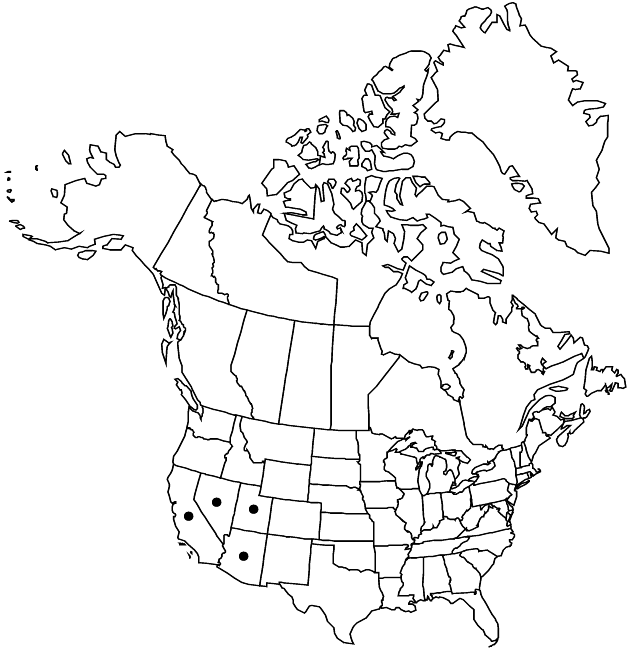Cirsium mohavense
Bot. Tidsskr. 31: 68. 1911.
Biennials or perennials, 30–250 cm; taprooted. Stems 1–several, erect, proximally simple, distally branched, ± densely gray-tomentose; branches 0–many, ascending to spreading. Leaves: blades oblongelliptic to oblanceolate, 10–60 × 2–15 cm, unlobed and merely spinulose or spiny-dentate or shallowly to deeply pinnatifid, lobes linear-lanceolate to ovate-triangular, spreading, entire to coarsely dentate, main spines slender to stout, 3–30 mm, faces ± gray-tomentose, sometimes ± glabrate; basal often present at flowering, winged-petiolate; principal cauline decreasing distally, proximal winged-petiolate, distal sessile, bases decurrent as spiny wings 1–5 cm; distalmost well separated, bractlike. Heads 1–many, in corymbiform or paniculiform arrays. Peduncles 0–15 cm. Involucres ovoid to hemispheric, 1.5–2.5 × 1.5–2 cm, loosely arachnoid on phyllary margins or glabrate. Phyllaries in 5–8 series, imbricate, (inner greenish to brown or stramineous), lanceolate or ovate (outer) to linear-lanceolate (inner), entire, abaxial faces with narrow glutinous ridge; outer and middle appressed, spines spreading, 3–7 mm; apices of inner often flexuous, flattened, spineless, scabrid. Corollas white to pink or lavender, 16–25 mm, tubes 7–12 mm, throats 4–7 mm, lobes 4–8 mm, style tips 3–4 mm. Cypselae stramineous to dark-brown, 3–6 mm, apical collars 0.2–0.3 mm, yellowish; pappi 14–16 mm. 2n = 30, 32.
Phenology: Flowering summer–fall (Jun–Oct).
Habitat: Wet soil, streams, springs, meadows in desert and desert woodland areas
Elevation: -50–2200 m
Distribution

Ariz., Calif., Nev., Utah.
Discussion
Of conservation concern.
Cirsium mohavense ranges from scattered sites in eastern California east in the Basin and Range Province of southern Nevada to southwestern Utah and nortwestern Arizona, mostly in Mojave Desert region. When Welsh proposed Cirsium virginense for a geographically limited group of plants from southwestern Utah and northwestern Arizona (and subsequently discovered in extreme southeastern Nevada), he indicated that its relationship to other western thistles was unknown. Subsequently, he indicated (S. L. Welsh 1983; Welsh et al. 1993) that the affinities of the taxon apparently lie with C. mohavense, but he did not attempt to distinguish C. virginense from C. mohavense (in the strict sense) because the latter was not known to occur in Utah. A. Cronquist (1994) attempted the distinction. The only character he used in his key was life span of the plants: biennial (C. mohavense) versus perennial, spreading by creeping roots (C. virginense). In the descriptions of the two taxa he elaborated on this character, indicating that C. mohavense is single-stemmed and C. virginense often multistemmed. In the remaining features the plants are very similar or overlap extensively.
Distinction of two taxa on the basis of duration is impractical and probably inaccurate. Specimens commonly lack roots, and in those specimens in which bases are present, I have seldom been able to make any distinction between biennial taproots and perennial taproots. In particular I have seen no evidence of creeping roots. I am not aware of any study of either taxon that documents the life history of the plants. Some specimens of C. mohavense (in the strict sense) appear to have perennial bases like those attributed to C. virginense by Cronquist. For instance, a specimen of C. mohavense from Death Valley (Thorne & Ratcliff 2287, BRY) is indistinguishable from specimens of C. virginense (e.g., Atwood 13374, BRY) from Nevada and Utah. Both have a branched root crown with multiple rosettes and nearly identical leaves and heads.
Selected References
None.
Lower Taxa
"fine" is not a number.